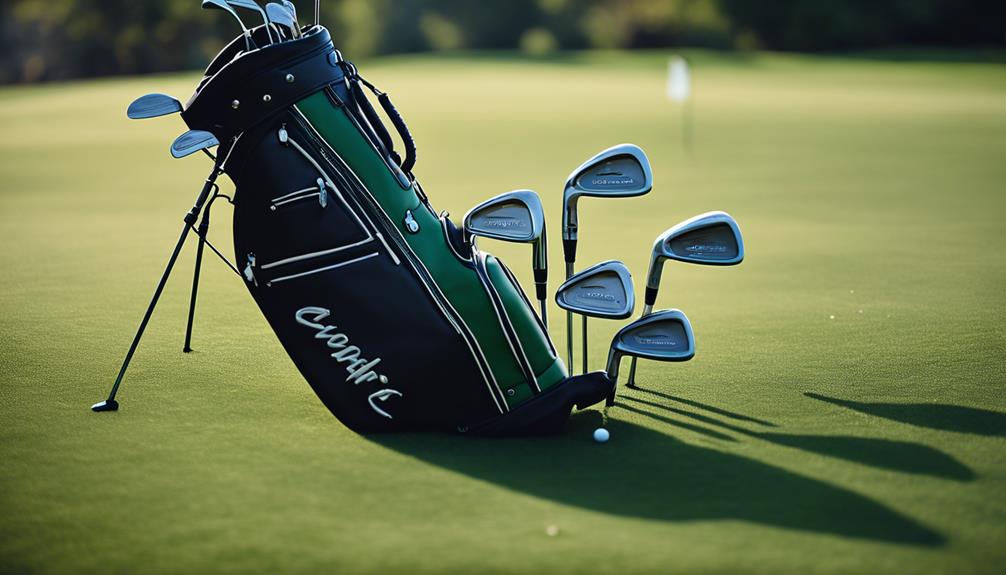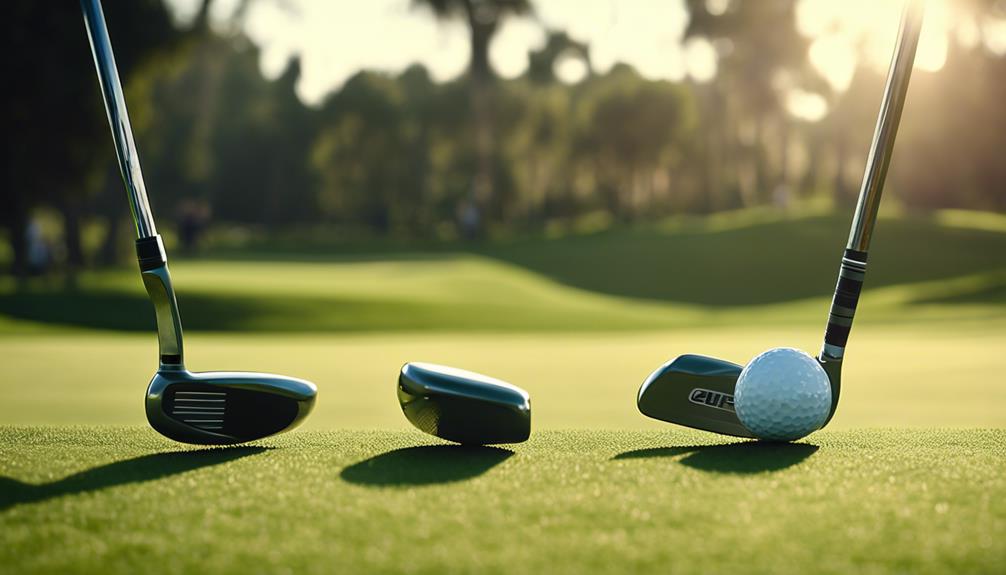- 7 Top Flite Golf Clubs XL for Improved Performance - September 28, 2024
- Top Flite Golf Clubs: Top 5 Reasons to Choose Them - September 28, 2024
- Top 3 Golf Club Fitters for a Perfect Swing - September 28, 2024
You'll be well-equipped to tackle the course once you familiarize yourself with the five main types of golf clubs: woods, irons, hybrids, wedges, and putters. Woods are designed for long-distance shots, while irons provide control and accuracy for mid-range shots. Hybrids offer forgiveness and versatility, and wedges are essential for precision shots around greens. Putters, meanwhile, are specialized for a smooth ball roll with minimal backspin. By understanding the unique characteristics and uses of each club type, you'll be able to optimize your game and make informed decisions on the course – and that's just the beginning of mastering your golf game.
Key Takeaways
- Woods and fairway woods are designed for long-distance shots, with drivers typically having lofts between 8-12 degrees.
- Irons are divided into short irons (8-iron to pitching wedge) and long irons (2-iron to 4-iron), each suited for specific shots.
- Hybrids combine the benefits of woods and irons, offering ease of use and forgiveness on off-center hits for longer approach shots.
- Wedges, including gap wedges, are ideal for approach and chip shots, with higher loft angles than irons.
Club Composition and Customization
With a maximum of 14 clubs allowed in your bag, you can strategically curate a mix of woods, irons, hybrids, wedges, and putters to optimize your game performance. Among the numerous golf clubs available, you'll want to select a combination that suits your playing style and preferences.
Golfers use a variety of clubs to tackle different shots, and understanding the characteristics of each type is essential for effective customization. When it comes to club composition, you'll need to balance distance and accuracy.
You can mix and match clubs to create a tailored set that addresses your strengths, weaknesses, and the demands of the course. By doing so, you'll be better equipped to tackle specific shot requirements, such as long drives or precise approach shots.
The key is to identify the types of clubs that work best for you and allocate them wisely in your golf bag. With the right club composition and customization, you'll be well on your way to improving your overall game performance.
Understanding Woods and Fairway Woods
Your longest shots rely on woods, including drivers and fairway woods, which are precision-engineered to maximize distance and speed.
These clubs are designed to help you achieve the greatest distance potential on the course.
Here are some key characteristics of woods and fairway woods:
- Designed for long-distance shots, with drivers typically having a loft between 8-12 degrees for maximum distance off the tee.
- Fairway woods feature larger clubheads and are suitable for various lies, including off the tee and from the fairway.
- Hollow clubheads contribute to their lightweight nature, allowing for faster swings and longer shots.
- Many modern fairway woods feature adjustable loft and lie settings, enabling golfers to customize their equipment for specific playing conditions and preferences.
Irons and Their Various Uses

As you explore the world of irons, you'll discover that selecting the right club for your shot depends on a range of factors, including distance, trajectory, and spin.
You'll need to contemplate the characteristics of short irons, which offer precision and control, as well as long irons, which provide power and distance.
Short Irons
You'll typically reach for short irons, including the 8-iron, 9-iron, and pitching wedge, when you need to make precision shots from the fairway or rough, leveraging their higher loft angles to achieve greater accuracy and control. These clubs are designed to help you hit approach shots to the green, usually ranging from 100 to 150 yards, depending on your skill and club selection.
Here are some key characteristics of short irons:
- Feature smaller clubheads than woods, often with grooves on the clubface to enhance grip and spin on the golf ball.
- Have shorter shaft lengths, providing better accuracy and control for challenging shots.
- Are ideal for shots from tight lies or when aiming for specific pin placements.
- Include the pitching wedge, which offers loft angles ranging from 44 to 48 degrees for higher flight and softer landings.
Iron Selection Tips
When steering through the various types of irons and their uses, selecting the right club for a specific shot requires careful consideration of factors such as distance, lie, and personal skill level.
As you navigate the sub-set of irons, remember that each club is designed for a specific purpose, and choosing the right one can make all the difference in your game.
For instance, when approaching the green from moderate distances, a pitching wedge with a loft angle between 44-48 degrees is an excellent choice. However, if you're dealing with a tricky lie, you may need to opt for a different type of wedge, such as a gap or sand wedge.
Iron selection tips also involve considering the shaft material, as steel and graphite options influence weight and flexibility, ultimately impacting performance and accuracy.
Long Iron Options
With their lower loft angles and smaller clubheads, long irons, comprising the 2-iron, 3-iron, and 4-iron, are designed to tackle longer distance shots, typically exceeding 200 yards. When you hit the ball with a long iron, you can expect a flatter trajectory and greater distance due to the lower loft angles, which range from 18 to 24 degrees. However, this also means you'll need to be more precise with your swing, as the smaller clubheads can be challenging to hit.
Here are some key things to keep in mind when using long irons:
- They're ideal for shots requiring a lower trajectory and more roll.
- You'll need to develop a smooth swing and clean ball strike to get the most out of them.
- Many golfers find long irons difficult to use and often replace them with hybrids, which offer a more forgiving option.
- Long irons require more skill and control than higher-numbered irons.
Hybrids: Combining Power and Precision
As you consider adding hybrids to your golf bag, you'll appreciate how they make it easier to hit long shots with precision.
By replacing traditional long irons, hybrids offer a more forgiving and versatile option for your game.
With their unique design, you'll find it's easier to achieve a higher launch angle and improved ball flight, even from challenging lies.
Easy to Hit
By incorporating the benefits of both woods and irons, hybrids have emerged as a game-changer for golfers of all skill levels, providing a unique combination of power and precision that makes them easy to hit.
When it comes to types of golf clubs, hybrids are a great option for those looking to improve their game. Here are some key benefits that make hybrids easier to hit:
- They feature a larger clubhead than traditional long irons, increasing forgiveness on off-center hits.
- Hybrids are numbered like irons (2-5) and are particularly effective for longer approach shots, providing better accuracy and distance control.
- The lower center of gravity allows for higher launch angles, making it easier to get the ball airborne, especially from challenging lies.
- Many golfers find hybrids to be a versatile option that can replace long irons in their bag, enhancing overall performance on the course.
Long Iron Replacement
You can confidently swap out your long irons for hybrids, which have emerged as a superior option for golfers seeking to improve their approach shots and overall game.
Hybrids, often referred to as utility clubs or rescue clubs, offer a versatile option for tackling various course conditions. Designed to replace long irons, hybrids are typically numbered like irons (2-5) and are easier to hit, providing better accuracy and distance. Their clubhead design features a larger profile, similar to fairway woods, allowing for a higher launch angle and more forgiving shots compared to traditional long irons.
When approaching greens from long distances, hybrids are particularly beneficial. They produce a higher trajectory and softer landing on the green, making them ideal for golfers who struggle with accuracy and control.
As a result, hybrids have become a staple in many golfers' bags, replacing hard-to-hit long irons. With their ability to deliver power and precision, hybrids are an excellent choice for golfers seeking to master their approach shots and take their game to the next level.
Wedges and Putters: Short Game Mastery

When it comes to maneuvering the intricacies of the short game, mastering wedges and putters is essential for golfers seeking to improve their overall performance. Wedges are used to tackle tricky approach shots and chip shots around the greens, thanks to their higher lofts that enable higher shots with quick stops on the green. You'll find various types of wedges, including pitching, sand, gap, and lob wedges, each designed for specific short-game situations.
Here are some key aspects to reflect upon when it comes to wedges and putters:
- Wedges have higher loft angles than irons, making them ideal for approach shots and chip shots.
- Gap wedges are used to fill the distance gap between your pitching wedge and sand wedge.
- Putters are the most specialized clubs, designed to promote a smooth ball roll with minimal backspin.
- Mastering the use of putters is essential for scoring, as it directly impacts your performance on the putting green.
Choosing the Right Club for Success
Selecting the right club from your bag is essential to executing a well-played shot, as each club is designed to excel in specific situations and distances. You need to choose the right club that suits the shot you're about to take, considering factors like distance, accuracy, and control.
Here's a breakdown of the types of golf clubs and their ideal uses:
| Club Type | Ideal Use |
|---|---|
| Woods | Maximum distance off the tee, fairway shots |
| Irons | Mid-range shots, better control and accuracy |
| Hybrids | Forgiving, versatile club for various lies |
| Wedges | Precision shots around the greens, high-angle shots |
When choosing the right club, consider the loft angle, club face, and your personal swing style. For instance, if you're looking for better control on approach shots, a fairway wood might be a better choice than a driver, even though it's designed for distance. By understanding the strengths of each club, you'll be able to make informed decisions on the course, leading to improved performance and a more enjoyable game.
Frequently Asked Questions
How Many Types of Clubs Are There in Golf?
You'll find that there are numerous types of golf clubs, made from various materials, with specific fitting guidelines, and offered by top brands, each with a rich history, requiring precise maintenance, but there are five main categories.
When to Use Woods Vs Irons?
"In ancient Greece, Hercules would've swung for the fences with woods, but you'll need strategy. You'll opt for woods when distance is key, leveraging their advantages, while irons provide accuracy benefits; consider swing mechanics, course conditions, and your skill level to master club selection."
How to Identify Golf Clubs?
When identifying golf clubs, you'll examine club materials, lengths, and grip types, considering factors like club brands, fitting, and swing styles to guarantee the right club for your game, maximizing performance and precision.
What Does P Stand for on Golf Club?
"Practice makes perfect" and understanding your gear is key. You're wondering what "P" stands for on your golf club – it's the Pitching Wedge, designed for approach shots and short-distance plays, with a purpose-built design and grip to master the short game.
Conclusion
As you stand on the green, club in hand, the game unfolds like a canvas waiting for the master stroke.
You've navigated the nuances of composition and customization, wielded the power of woods and irons, and harnessed the precision of hybrids and wedges.
Now, with putter in hand, the final brushstroke awaits.
With the right club, your game is a work of art, each shot a deliberate stroke that brings you closer to perfection.




